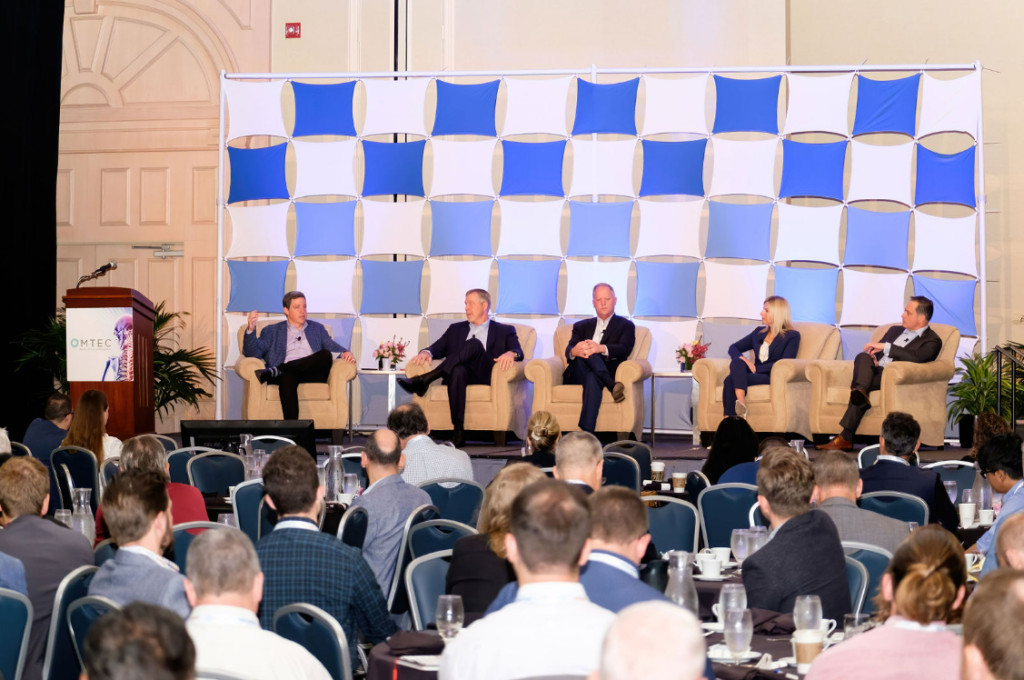
For as many challenges that orthopedic companies currently face, the future holds plenty of opportunities. Orthopedic device company executives who spoke at OMTEC® 2022 shared their observations on emerging technologies and ways that they could further evolve the industry in the next five to ten years.
The OMTEC 2022 Keynote address on the State and Future of the Orthopedic Industry brought together:
- Brady Shirley, President and COO, Enovis
- Curt Hartman, President and CEO, CONMED
- Rebecca Whitney, Senior Vice President and President, Global Spine, ZimVie
- Eric Major, an Advisor at Major Advisory Group and former President of K2M and Stryker Spine
Moderated by Matt O’Brien, Senior Research Analyst and Managing Director at Piper Sandler, executives shared how they perceive new, evolving technologies and shifts in site of care, elements impacting the future of orthopedics.
Additive Manufacturing, Materials and Personalized Medicine
Orthopedic device companies often consider how enhanced manufacturing and material capabilities can gain them process efficiencies and better patient outcomes. The OMTEC panel discussed the role of additive manufacturing (AM), materials and personalization in orthopedics.
Major noted that K2M was early to embrace additive AM in the spine segment. Orthopedic implants have evolved greatly over time, with preferred materials changing from titanium to PEEK to now the use of titanium with AM. He said that he didn’t know what was coming next, but that another material of interest will likely gain momentum with the next generation of orthopedic surgeons.
In the arena of joint replacement, Shirley said that he expects to see a shift away from cobalt chrome and likely toward ceramics. Cobalt chrome as an implant material is under greater scrutiny, particularly in the EU. It’s been rebuked for a number of aspects, Shirley said. Plus, ceramics appeal to him because they have proven to be very durable, strong and have a “phenomenal” ability to mitigate infection.
In continuing the conversation about materials, Hartman asked how the orthopedic industry combines traditional materials and orthobiologics to make more personalized combination products. Healthcare is becoming more personalized, he observed. If a surgeon operates on three patients with shoulder conditions, he will see different issues, yet will have one device to address the three variations.
“There may be a way to be more personalized with that combination of materials,” Hartman said. “That’s the bigger picture, long term.”
Patient-specific implants, especially with the use of AM, have been a point of discussion for years, Major added. From an FDA regulatory standpoint, though, it’s hard to get right. However, new technology, like AI, could bring personalized medicine to the forefront faster.
Predictions on New Technology
Orthopedics has seen a proliferation of enabling and digital technologies from companies of all sizes in recent years. While still in its infancy, implant and software companies see a home for this technology in orthopedics.
Whitney said that she thinks the real opportunity for disruptive innovation lies beyond the implant. When talking about enabling technology, most people gravitate towards robotics. While that certainly has a place in the orthopedic sphere, she said, it has not taken hold yet in the spine segment — sometimes due to cost constraints.
Being able to use data to predict with a high level of confidence how a patient should be treated, and using the right tech to make that happen, is where she believes orthopedics will move.
“I think the next step is to determine exactly which procedures need what type of support,” she said. “I think coupling that and being very mindful of the cost considerations at the same time is what will allow us to find a way to move some of this innovation forward.”
Major agreed with Whitney, saying that what she described will likely come about over the next five years. Since orthopedic companies are primarily paid for implants, one hurdle that companies face is making sure that they bundle these new technologies into their cost structure.
Ambulatory Surgical Centers
Things take a long time in medicine, Major said, and talks about the widespread implementation of ambulatory surgical centers (ASCs) is no exception. The shift of orthopedic procedures to outpatient settings has been slower than initially anticipated. However, industry has seen the momentum of surgeries moving to ASCs thanks to the pandemic.
“We’ve seen a significant, increased utilization of the ASC environment because of COVID and people wanting not to go into hospitals, yet still find procedural solutions,” Major said.
Whitney, who previously oversaw Zimmer Biomet’s ASC business, agreed that ASCs are accelerating, due to the movement of knees, hips and spine procedures to these environments.

Orthopedic executives gave insight on their predictions for the future of the industry at From left to right, pictured are Matt O’Brien, Brady Shirley, Curt Hartman, Rebecca Whitney and Eric Major. Photo courtesy of AltPhoto.
“If you’re a surgeon and you’re an owner/operator of an ASC, once they do that, they don’t want to go back to the hospital because they’ve got more autonomy and it’s better for the payors,” she said. “If you look at the stakeholders that are involved, and I agree with Eric, I think people are taking a much more open-minded approach to this now; I think people are recognizing this is here to stay because it just makes so much more sense.”
More often, Whitney continued, patients are saying, “I want this type of procedure, and I want it done in a surgery center.” She thinks that the industry will continue to see the healthcare consumer driving a lot of shifts.
In terms of future volume, Whitney thinks the industry will not only see more basic spine cases shift to ASCs, but also more complex cases.
O’Brien asked about the logistical challenges of performing a procedure there vs. a hospital. Hartman, whose company primarily serves the orthopedic sports medicine market at ASCs, said that the model is very efficient.
Shirley was asked about the challenges associated with serving the ASC environment. Instrument turns are critical to all businesses, he said. It is a devastating challenge if the instrument turns are off.
“I think the only way that we solve this collectively is by thinking very flexibly and differently about what these customer requirements are, because they are very different,” Whitney added. “So our conversations [with surgeons] would quickly pivot to be more holistic. Let’s talk about your profitability, let’s talk about where you have waste. It always came down to storage, sterilization and staff. Those are the three biggest areas of cost.”
Whitney concluded by saying that while it’s often difficult to get surgeons to change, once they have a vested interest in the bottom line, they become more open.




